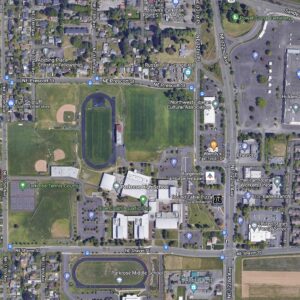Gem of Oregon: Safe Routes to Schools
Safe Routes to Schools (SRTS) is mentioned 13 times in the Bicycle Pedestrian Plan. Five are simple references. This program is the star of Oregon’s bicycle and pedestrian evolution but it is but a token of support by ODOT.
SRTS was started by an annual 1 million federal dollars line item for each state and has had to be renewed each year until the Map 21 budget. The Feds stopped the program and said to the states: it is okay to take the SRTS support from other parcels of Fed active transportation money…14 states terminated SRTS. Admirably, Oregon continued support and it does so today. We do thank them. BUT.
SRTS is still a step child shunted in the attic. ODOT has this program in the Safety division. Sounds logical. Safety budget is 32 million. Sounds good. BUT.
Safe Routes to Schools should be the centerpiece of the Bicycle Pedestrian Plan. It is an intergeneration program. It brings two generations into Active Transportation. It teaches traffic from the perspective of the pedestrian and the vulnerable roadway user. It teaches that destinations can be within active transportation range. It converts short automobile trips of 1 to 3 miles into active transportation. It teaches daily exercise which reduces the numbers of sedentary-related obese kids. And this teaches that narcissistic automobile and bicycle behavior is bad.
We all know these concepts. ODOT could be an agent of change here. 40 to 60 percent of grant applications to Oregon Bicycle & Pedestrian 1% gas tax funding include the word ‘school’ or the phrases similar to ‘connects school to major neighborhood’ as rationales for their proposals. We also know that parents in Redmond drive their kids less than a mile to cross Hwy 97. Highway 101 represents the same barrier in Newport and Tillamook for kids safely getting to school. Other applications of STIP, the old Enhancement program, & ConnectOregon funding sources use the 500 miles of missing sidewalks to illustrate the applicant’s needs
The Plan could really change the next generations by placing SRTS as a primary strategy. This would unify where to put dollars and make schools the destination target of safe bicycle and pedestrian ways and intersections.
The only reason that SRTS in stuck in the Safety division is it makes us feel good. If you look at the crash maps of Portland, one can see how few deaths and crashes occur near schools.
Making SRTS as the primary goal of Active Transportation will automatically give a strong focus to quiet streets, create safer intersections, & leverage health benefits to children. Imagine creating an integrative section of the Transportation Developmental Division to bundle the 500 miles of documented needed sidewalks with focus on prioritizing the sidewalks to schools. This would refashion intersections for improved sight lines, reduce speeds in neighborhoods rather than limiting speed in a 2 block school zone, and create calming measures for multi-lane roadway crossings.
Bundling all grants for sidewalks around SRTS will create an efficiency across the five ODOT regions. Instead of having community compete against community, approach the problem that ALL school arterials will be complete. SRTS is the on~the~ground section of ODOT to direct priorities of how to accomplish this state-wide. SRTS has this insight that policy makers need, otherwise management of sidewalk completion is piecemeal.
Another potential exists: In the Springfield educational district, a position was created by two funding streams: SRTS and Dept of Education. The position helped coordinate the Safe Routes program and assisted the Dept of Ed’s school bus program. The potential for solidifying two pupil transportation programs and integrating efforts is a great model. Combining the $260 million school bus program with the $600 thousand SRTS program integrating school transportation is missing in the Bicycle and Pedestrian Plan. Given that the Dept of Education budget is such a wrangle each legislative session and given ODOT’s pledge to delete 5% of their staff, this is a great joint partnership.
I see the short-coming of this large document, Bicycle Pedestrian Plan, is not in its wonderfully detailed inventory, but in its asking what can ODOT do for active transportation? How do we integrate services more efficiently, create a greater impact on those following us and sustain a health and vibrancy that no other state has? I wince that we have lost a leadership who welcomes integration and efficiency and relies on squirreling away monies, projects, and divisional territories which, in effect, lowers the glass ceiling on active transportation.
— Only paying subscribers can post in this section, but everyone can read and comment. Learn more about our subscription program here.





Is it any surprise that agencies that exist to enable the automobile are backing away?
We need to acknowledge the conflict here and stop relying on the auto boosters to do something to enable non-auto transportation. Just as transit agencies have proven that they couldn’t care less about non-transit needs.